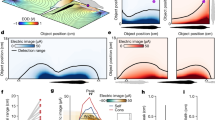Abstract
MANY Procellariiform seabirds make their living flying over vast expanses of seemingly featureless ocean waters in search of food. The secret of their success is a mystery, but an ability to hunt by smell has long been suspected1–7. Here we present experimental evidence that Procellariiform seabirds can use a naturally occurring scented compound, dimethyl sulphide, as an orientation cue. Dimethyl sulphide has been studied intensely for its role in regulating global climate8–11 and is produced by phytoplankton in response to zooplankton grazing12. Zooplankton, including Antarctic krill (Euphamia super ha)13, are in turn eaten by seabirds and other animals14. Results from controlled behavioural experiments performed at sea show that many Procellariiforms can detect dimethyl sulphide, and that some species (for example, storm petrels) are highly attracted to it. To our knowledge, this constitutes the first evidence that dimethyl sulphide is part of the natural olfactory landscape overlying the southern oceans.
This is a preview of subscription content, access via your institution
Access options
Subscribe to this journal
Receive 51 print issues and online access
$199.00 per year
only $3.90 per issue
Buy this article
- Purchase on Springer Link
- Instant access to full article PDF
Prices may be subject to local taxes which are calculated during checkout
Similar content being viewed by others
References
Grubb, T. C. Nature 237, 404–405 (1972).
Bang, G. B. Nature 205, 513–515 (1965).
Hutchison, L. V. & Wenzel, B. M. Condor 82, 314–319 (1980).
Lequette, B., Verheyden, C. & Jouventin, P. Condor 91, 732–735 (1989).
Clark, L. & Shah, P. S. in Chemical Signals in Vertebrates (eds Doty, R. & Meuller-Schwarze, H.) (Plenum, New York, 1992). pp. 421–427.
Verheyden, C. & Jouventin, P. The Auk 111, 285–291 (1994).
Nevitt, G. A. Soc. Neurosci. Abstr. 20, 168 (1994).
Bates, T. S., Charlson, R. J. & Gammon, R. H. Nature 329, 319–321 (1987).
Charlson, R. J., Lovelock, J. E., Andreae, M. O. & Warren, S. G. Nature 326, 655–661 (1987).
Bates, T. S., Calhoun J. A. & Quinn, P. K. J. geophys. Res. 97 (D9), 9859–9865 (1992).
McTaggart, A. R. & Burton, H. J. geophys. Res. 97 (C9), 14407–14412 (1992).
Dacey, J. W. H. & Wakeham, S. G. Science 233, 1314–1316 (1986).
Tokunaga, T., Iida, H. & Nakamura, K. Bull. Jpn Soc. Sci. Fish. 43, 1209–1217 (1977).
Prince, P. A. & Morgan, R. A. in Seabirds: Feeding Ecology and their Role in Marine Ecosystems (ed. Croxall, J. P.) 135–171 (Cambridge University Press, Cambridge, UK, 1990).
Croxall, J. P. & Prince, P. Biol. J. Linn. Soc. 814, 103–131 (1980).
Dusenbury, D. B. Sensory Ecology: How Organisms Acquire and Respond to Information (Freeman, New York, 1992).
Berresheim, H., Andreae, M. O., Ayers, G. P. & Gillett, R. W. in Biogenic Sulfur in the Environment (eds Saltzman, E. S. & Cooper, W. J.) 352–366 (Am. Chem. Soc., Washington DC, 1989).
Zar, J. H. Biostatistical Analysis 2nd edn (Prentice-Hall, Englewood Cliffs, NJ, 1984).
Elkinton, J. S. & Carde, R. T. in Chemical Ecology of Insects (eds Bell, W. J. & Cardé, R. T.) 73–91 (Sinauer, Sunderland, MA, 1984).
David, C. T., Kennedy, J. S. & Ludlow, A. R. Nature 303, 804–806 (1983).
Warham, J. The Petrels: Their Ecology and Breeding Systems (Academic, London, 1990).
Harrison, N. M. et al. The Auk 108, 801–810 (1991).
Hayes, B. P. & Brooke, M. de L. Vision Res. 30, 1277–1289 (1990).
Harper, P. C. Notornis 34, 169–192 (1987).
Bang, B. G. Acta. anat. 65, 391–415 (1966).
Keller, M. D., Bellows, W. K. & Guillard, R. R. L. in Biogenic Sulfur in the Environment (eds Saltzman, E. S. & Cooper, W. J.) 167–182 (Am. Chem. Soc., Washington DC, 1989).
Waldvogel, J. The Auk 104, 369–379 (1987).
Papi, F. in Avian Navigation (eds Papi, F. & Walraff, H. G.) 149–159 (Springer, Berlin, 1982).
Wallraff, H. G. J. comp. Physiol. 139, 411–422 (1981).
Pennycuick, C. J. in Seabirds: Feeding Biology and Role in Marine Ecosystems (ed. Croxall, J. P.) 43–62 (Cambridge University Press, Cambridge, UK, 1990).
Author information
Authors and Affiliations
Rights and permissions
About this article
Cite this article
Nevitt, G., Veit, R. & Kareiva, P. Dimethyl sulphide as a foraging cue for Antarctic Procellariiform seabirds. Nature 376, 680–682 (1995). https://doi.org/10.1038/376680ao
Received:
Accepted:
Issue Date:
DOI: https://doi.org/10.1038/376680ao
This article is cited by
-
The biogeochemistry of marine dimethylsulfide
Nature Reviews Earth & Environment (2023)
-
The role of chemical cues in locating the host pelagic Sargassum spp. by the symbiotic fish Stephanolepis hispidus
Symbiosis (2023)
-
Two species of seabirds foraged in contrasting marine habitats across the cold-water belt along the coast of northern Hokkaido in the southwestern Okhotsk Sea
Fisheries Science (2022)
-
Natural dimethyl sulfide gradients would lead marine predators to higher prey biomass
Communications Biology (2021)
-
Olfaction of aquatic amniotes
Cell and Tissue Research (2021)
Comments
By submitting a comment you agree to abide by our Terms and Community Guidelines. If you find something abusive or that does not comply with our terms or guidelines please flag it as inappropriate.



